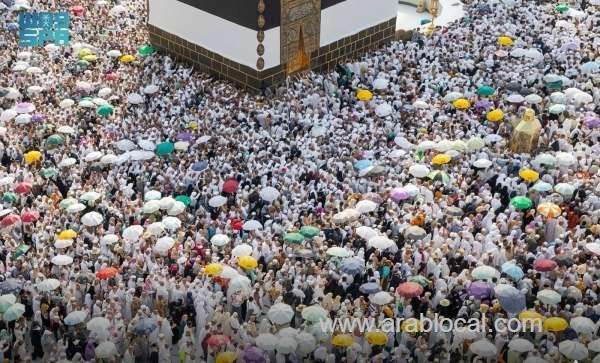Most pilgrims started leaving the tent city of Mina on Tuesday afternoon, the second day of Tashreeq, after performing the ritual of casting stones at the three Jamarat, pillars symbolizing Satan.
Chanting “Allahu Akbar'' (God is the greatest), pilgrims hurled stones first at Jamarat Al-Sugra (small pillar), then at Jamarat Al-Wusta (medium pillar), and lastly at Jamarat Al-Aqaba (largest pillar), seven times each. They prayed after stoning the first two pillars and quickly exited after stoning the third Jamarat, following the tradition of the Prophet Muhammad (peace be upon him).
Pilgrims in a hurry proceeded to the Grand Mosque in Makkah to perform Tawaf Al-Wida (Farewell circumambulation around the Holy Kaaba), the last obligatory ritual of Hajj. The Grand Mosque received several batches of pilgrims, who arrived from Mina to perform the Tawaf Al-Wida, before heading to visit the Prophet’s Mosque in Madinah or returning home. The pilgrims were in a spiritually elevated and euphoric mood after completing their lifetime spiritual journey.
Pilgrims in a rush are allowed to leave Mina for Makkah before sunset on the second Tashreeq day; otherwise, they must stay an extra day in Mina and perform the stoning ritual again. The majority of the pilgrims vacated Mina before sunset on Tuesday. Those remaining in Mina on Tuesday night will leave the tent city after completing the stoning ritual on Wednesday afternoon.
Authorities made elaborate arrangements for the departure of pilgrims from Mina as per a two-day schedule to avoid congestion at the Jamarat Bridge and ensure smooth movement to the Grand Mosque for Tawaf Al-Wida. Pilgrims performed the stoning ritual in an orderly and peaceful manner, emulating Prophet Ibrahim’s stoning of the devil at the three spots where he is said to have appeared to dissuade him from obeying God’s order to sacrifice his son, Ismail. The ritual symbolizes the renunciation of evil in all its forms and a promise never to succumb to Satan's machinations. Pilgrims moved easily from one pillar to the next, hurling pebbles at the pillars. Multiple lanes were allocated for smooth movement to the multi-level Jamarat Bridge complex.
Pilgrims proceeded from their camps in Mina to the Jamarat Complex at their scheduled time on Tuesday afternoon. They reached the Jamarat by Mashaer Train and buses, while pilgrims in tents near the Jamarat walked to the facility. After completing the stoning ritual, pilgrims returned to their accommodation in Mina, packed their baggage, and boarded buses to Makkah to perform the Farewell Tawaf. Although Hajj, one of the five pillars of Islam, officially concludes on Wednesday, the third day of Tashreeq, pilgrims are allowed to leave a day earlier.
The stoning ritual took place under the soaring summer heat, which at 2 p.m. reached 48 degrees Celsius in Makkah and the Holy Sites, according to the Saudi National Center for Metrology. “Of course, it is something very hard and tiring. The temperature is abnormal compared to past years, and this affects us a lot,” said Ahmed Al-Baradie, an Egyptian pilgrim, after performing the stoning ritual. More than 2,760 pilgrims suffered from sunstroke and heat stress on Sunday alone at the start of the first round of stoning, according to the Health Ministry.
Health Minister Fahd Al-Jalajel urged pilgrims on Monday to avoid peak sun hours from 11 a.m. to 4 p.m. when performing the remaining stoning rituals. He advised them to avoid direct sun exposure and hot surfaces, stressing that prevention is key. The Ministry of Health reported treating 2,764 cases of heat stress on the first day of Eid. Security forces, medics, and first responders have been deployed in and around Mina, especially on roads and open areas, to direct and help pilgrims. They treated many people for sunburns on their feet.
Saudi authorities ensured smooth movement throughout the day, facilitating pilgrims’ access to the Jamarat Bridge for stoning, returning to their Mina tents, and heading to Makkah for the Farewell Tawaf. The Transport General Authority (TGA), in collaboration with relevant authorities, allocated 11 shuttle bus routes for transporting pilgrims between Mina and the Grand Mosque during the days of Tashreeq. The TGA provided 2,460 buses for pilgrim transport, aiming to facilitate their movement and ensure the completion of their rituals with ease, tranquility, and peace. This initiative also enhances transportation access, improves service quality, ensures operational efficiency, and improves the overall pilgrim experience.
The General Authority for the Care of the Affairs of the Two Holy Mosques, in collaboration with other entities involved in Hajj affairs, planned a smooth Farewell Tawaf by efficiently organizing the flow of pilgrims according to this year’s Hajj season protocols. A comfortable climate is maintained by a network of 883 air conditioning units, supplemented by 4,323 ventilation and misting fans. A dedicated team of 2,800 volunteers is available to assist pilgrims and give directions in 50 languages. Over 200 large electric carts and 10,000 wheelchairs are available for pilgrims in need.
Easy navigation is facilitated by 194 designated doors, 519 stairs, and 194 elevators throughout the Grand Mosque. A total of 33,000 prayer rugs and 340 prayer halls are designated for pilgrims. The Presidency for Religious Affairs of the Two Holy Mosques activated the “Walyattawafu” initiative during the third phase of the Farewell Tawaf. The initiative aims to streamline the Tawaf process by deploying guides and volunteers to assist pilgrims during the Farewell Tawaf.
More than 1.83 million Muslims performed Hajj this year, slightly less than last year’s 1.84 million, according to data released by the Saudi General Authority for Statistics (GASTAT).









